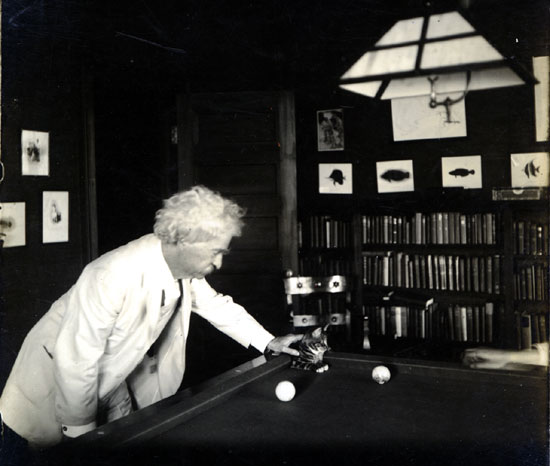|
>
Curated by Brent M. Colley, Heather Morgan and Lisa
Burghardt
Twain and Keller had
a Lot in Common:
1. Mark Twain
was born two months pre-mature in the frontier town
of Florida, Missouri. There was little hope of survival,
let alone success. Helen Keller lost her vision and
hearing at 19 months and thus she too had little hope
for success.
Both “survived” and
over came the great odds stacked against them to become
successful Activists, Authors, Public Speakers and Celebrities.
2. Both lost their fathers at a
young age. Twain's father died when he was 11 and Keller's
father died when she was 16.
3. Over the
course of her life Helen came to accept religious and
political beliefs quite different from those of her
family and friends. Helen Keller became a member of
the Socialist Pary in 1909 and by 1912, she had become
a national voice for socialism and working class solidarity.
These beliefs and causes differed grately from her teacher,
Anne Sullivan Macy's views. It was Anne's husband, John
Macy, a lecturer and radical journalist, who introduced
and taught Helen about socialist ideals. Throughout
her adult life Keller campaigned for women's suffrage,
labor rights and other humanitarian issues.
In explaination for why she crusaded for
these causes, she wrote, "I do not like this world
as it is. I am trying to make it a little more as I
would like to have it."
Twain was also a non-conformist when
it came to politics and religion. In 1902, he confessed:
"... I am a moralist in disguise; it gets me into
heaps of trouble when I go thrashing around in political
questions." And he spoke the truth about that, it
did get him in heaps of trouble and he did raise some
eyebrows speaking out against the United States new
thirst for global conquests. Twain was an anti-imperialist,
serving as vice president of the American Anti-Imperialist
League (which had a good number of Socialist members)
the last decade of his life. He was opposed to U.S.
intervention in the Philippines, explaining to the New
York Herald in 1900 that, "We have gone there to
conquer, not to redeem. . . . I am opposed to having
the eagle put its talons on any other land."
In pointing out the issues he had with
both the Democratic and Republican parties, his views
of partisanship ring true over a 100 years after they
were spoken:
"Look at the tyranny of party -- at what is called
party allegiance, party loyalty -- a snare invented
by designing men for selfish purposes -- and which
turns voters into chattels, slaves, rabbits, and all
the while their masters, and they themselves are shouting
rubbish about liberty, independence, freedom of opinion,
freedom of speech, honestly unconscious of the fantastic
contradiction; and forgetting or ignoring that their
fathers and the churches shouted the same blasphemies
a generation earlier when they were closing their
doors against the hunted slave, beating his handful
of humane defenders with Bible texts and billies,
and pocketing the insults and licking the shoes of
his Southern master."
As for his religious views, he stated
in 1906 that “(my Autobiography) will make a stir when
it comes out.” (100 years after his death.)
“In religion and politics
people's beliefs and convictions are in almost every
case gotten at second-hand, and without examination,
from authorities who have not themselves examined
the questions at issue but have taken them at second-hand
from other non-examiners, whose opinions about them
were not worth a brass farthing.”
- Autobiography of Mark Twain,
2010
Twain was well educated on the topic of religion; all
religions. He traveled the world, seeing a total of
35 countries and taking note of the religions practiced
in all of them.
"Monarchies, aristocracies, and religions....there
was never a country where the majority of the people
were in their secret hearts loyal to any of these
institutions."
- Mark Twain, The Mysterious Stranger
4. They both
dealt with people who wished to take advantage of them.
"As she had her entire life, the luminous Helen inspired
intrigues and power struggles, as her acquaintances
and advisers fought with one another to gain possession
of her."
The same can be said
for Twain who was swindled from his riches a number
of times over the course of his lifetime, and endured
a painful “power struggle” between his daughters and
business associates in the final year of his life.
5. Both were
animal lovers: Helen loved dogs and Twain loved cats.
Helen Keller had a lifelong love of dogs
and always had at least one or two by her side. When
she was a young girl, she even tried finger spelling,
her only way of communicating, into her dogs' paws.
Although Helen had many dogs throughout
her lifetime, she never used any of them as dog guides,
as many blind people do today. But as she made her way
through her gardens later in life, several dogs could
always be seen at her side.
Some of these dogs included a Great Dane
named Belle, a Scottie named Darkie, German Shepherds,
Collies, and even a Dachshund named Sunshine. Helen's
love for animals was so great that during many of her
trips, pictures were taken of Helen and many different
types of animals in countries all over the world.
Twain loved cats so much that he altered
the rules of his favorite game to accommodate their
presence:

From The Boys' Life of Mark Twain by Albert
Bigelow Paine: "...Of course there were several
cats at Stormfield, and these really owned the premises.
The kittens scampered about the billiard-table after
the balls, even when the game was in progress, giving
all sorts of new angles to the shots. This delighted
him, and he would not for anything have discommoded
or removed one of those furry hazards."
One of Twain's most popular quotes
on cats:
"Of all God's creatures there
is only one that cannot be made the slave of the lash.
That one is the cat.
If man could be crossed with the cat, it would improve
man, but it would deteriorate the cat."
6. Both traveled to 30+ foreign
countries and had their books translated into foreign
language editions.

7. They were
both well traveled but both chose Fairfield County as
their final homes.
During her lifetime,
Helen Keller traveled the World (39
Countries Visited) and lived in many different places—Tuscumbia,
Alabama; Cambridge and Wrentham, Massachusetts; Forest
Hills, New York, but perhaps her favorite residence
was her last, the house in Easton, Connecticut she called
"Arcan Ridge."
The same can be said
about Samuel L. Clemens. He too traveled the World (35
Countries Visited), lived in many places, and yet
fell in love with the beauty of his final residence…
Stormfield in Redding, Connecticut.
“I was never in this beautiful
region until yesterday evening. Miss Lyon and the
architect built and furnished the house without any
help or advice from me, and the result is entirely
to my satisfaction.” “It is charmingly quiet here.
The house stands alone, with nothing in sight but
woodsy hills and rolling country.”
-Samuel L. Clemens letter to Dorothy
Quick dated June 19, 1908
8. Both died
of heart disease. Helen Keller lived at 163 Redding
Road in Easton, Connecticut. She died in her sleep on
June 1, 1968 at the age of 87. The cause of her death
was arteriosclerosis heart disease (Twain died of Heart
troubles too. His were tied to his life long smoking
habit). Twain died in the twilight hours of April 21,
1910, at the age of 74.
9. Since their
deaths, their names have lived on…
Eulogy by Senator J.
Lister Hill of Alabama:
“She will live on, one of the
few, the immortal names not born to die. Her spirit
will endure as long as man can read and stories can
be told of the woman who showed the world there are
no boundaries to courage and faith.”
Twain's note to a news
reporter in 1897: "...the report of my death
was an exaggeration." Has some truth in it
to this day. Twain works, quotes and life story have
remained relevant since his passing. In 1910, the first
volume of his Autobiography was released with great
success and most recently- to celebrate the 176th anniversary
of Twain's birth Google painted its logo using its patented
"Doodle" to render the world of Twain's Tom Sawyer,
who famously cajoled friends to whitewash a fence for
him.
This exhibit has been made
possible by donations to the History
of Redding website and the generous
assistance of Helen Selsdon, archivist at the American
Foundation of the Blind in New York City.
Donations
to AFB can be made online.
|